The main difference between a banana and a plantain is their size and color; bananas are smaller and turn yellow as soon as they start to ripen, while plantains are larger and only turn yellow or brown once they are overripe. The texture and taste of the two are also different. Plantains have more starch and taste more like potatoes when cooked, while bananas are sweeter and softer even when eaten raw.
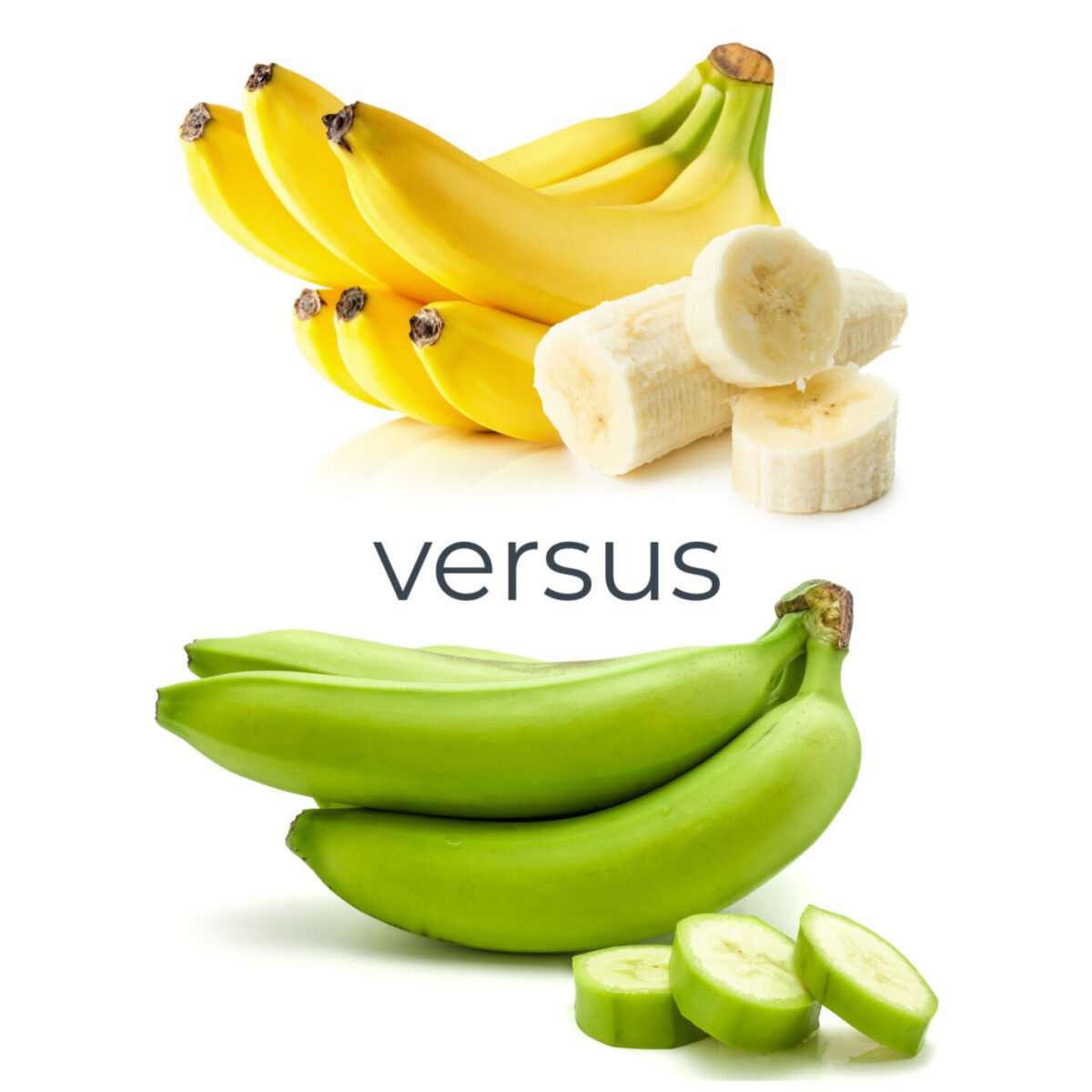
Because plantain is a type of banana, it may be difficult to distinguish at first. However, this article will discuss how these two finger-shaped fruits differ in appearance, flavor, texture, uses, nutrition, and storage.
Table of Contents
What’s the difference between bananas and plantains?
1. Appearance
At a glance, they both look quite similar, which is understandable as the plantain is part of the banana family. You could be forgiven for mixing up their shape, skin, and flesh as the differences aren’t obvious.
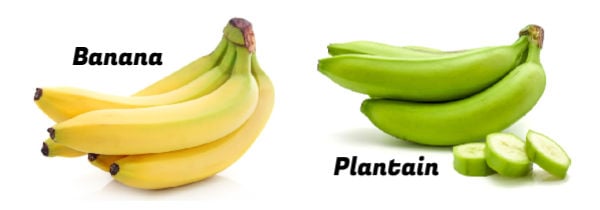
There are a few features that set the two apart. A banana starts out green but soon turns yellow as it ripens. Plantains remain green even when ripe and then eventually turn yellow or even black once overripe.
Plantains have thicker skin and grow longer than bananas. The average plantain is around 12” whereas a large banana might reach 9” in the right growing conditions.
The flesh inside each type of fruit is a very similar white color. If you slice a plantain in half, you’ll notice more starch content – a lot like what you’ll see when slicing a potato in half.
2. Flavor and Texture
Bananas have a tropical sweet taste, with a distinctive aroma and can be eaten raw as a snack thanks to their soft texture.
Plantains are a lot higher in starch, and cooking is recommended before eating. An uncooked plantain has virtually no flavor and a texture similar to a green banana. An unripe plantain, once cooked, will be crunchy but much softer. The longer a plantain is left to mature, the more sugar will develop.
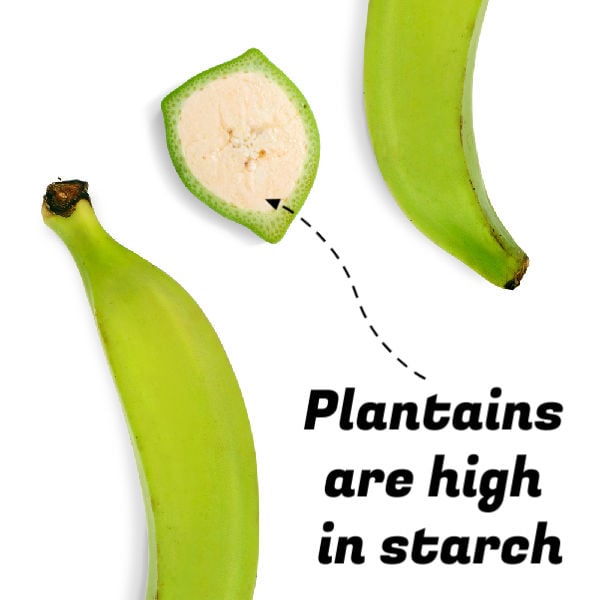
3. Uses
Thanks to their soft texture and high sugar content, bananas can be eaten raw, used in smoothies, fruit salads or cooked in desserts. They also offer a pop of sweet flavor in savory dishes such as Hawaiian chicken.
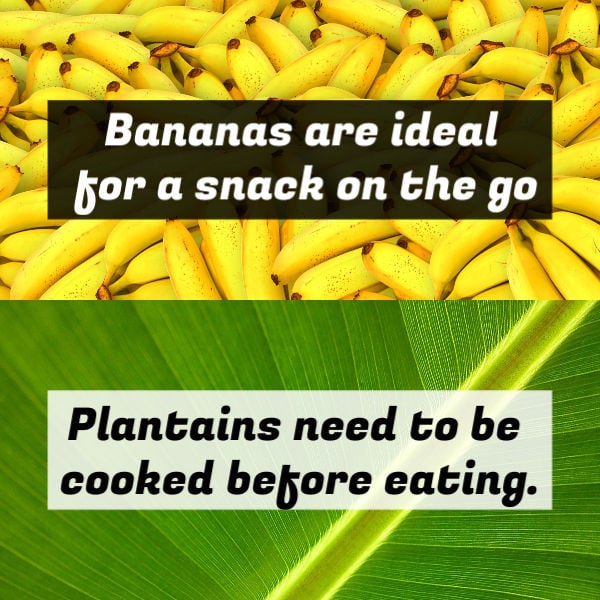
Plantains play a vital role in the traditional diets of the Caribbean, India, and Africa. It’s best to treat them as a vegetable such as potatoes or butternut squash when using them in recipes. Peel, then bake, fry or roast to reduce the unpleasant starchy flavor and texture. They're delicious cooked with ackee for a carb-loaded breakfast, along with saltfish.
Plantains are ideal for savory dishes, but they can also play a starring role in desserts. Caramelized and served with cinnamon and coconut for a simple, yet delicious sweet snack.
Quick Tip: Are you the do-it-yourself type? Dehydrate your plantains then grind into a low-allergen, gluten-free flour.
Related articles:
What are the best plantain substitutes?
Have you tried amla before? Find out what it tastes like here.
Find out how pandan tastes and whether you need it in your kitchen.
What can I use as a banana liqueur substitute?
How to Fry Plantains
If you’re looking for a recipe to cook plantains then frying is a popular option. This process reduces the starch and caramelizes the fruit so that it's more enjoyable to eat.
Watch the video.
Here's another recipe you might enjoy.
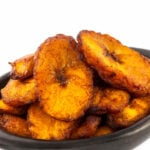
Fried Garlic Plantains
Ingredients
- 2 garlic cloves
- 4 plantains
- canola oil
Instructions
- Use a knife to peel the plantains. You may be able to peel them like a banana depending on how ripe they are.
- Slice the fruit into cubes or long slices based on your preference.
- On medium heat, add oil to a pan until hot then add the garlic and cook for 1 minute.
- Add the plantain and continue cooking, frequently stirring, for 10 minutes. It's ready when the outside has browned, and the inside is soft.
- Serve as a side dish for chicken, beef, fish or mixed into scrambled eggs for a flavorsome twist. You can also use fried plantain in slow-cooked meals such as casseroles and soups.
4. Nutrition
Which is healthier banana or plantain?
- Bananas are lower in carbohydrates than plantains but higher in fiber.
- Plantains are higher in calories than bananas.
- They are both low in fat and protein, but high in potassium, vitamin A and C.
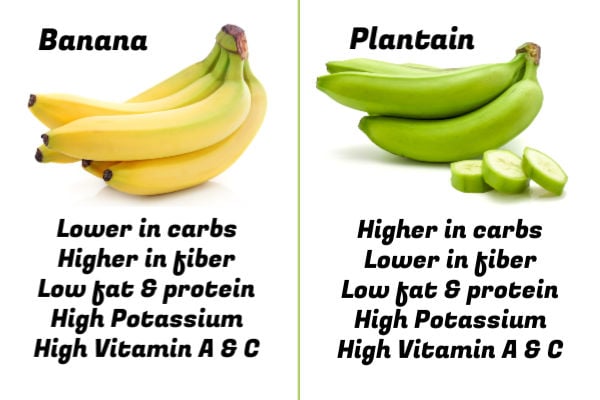
Source: https://www.nutritionix.com
5. Storage
Bananas will ripen a lot quicker than plantains. Store in a cool, dry position out of direct sunlight. If you need to slow down their ripening process, pop them in the vegetable crisper. It’s best to store bananas away from other fruit as the ethylene they release will cause the other fruit to over-ripen quickly.
Store plantains with other starchy vegetables like potatoes in a cool, dry place.
FAQs
Bananas would not make a good substitute for plantains in a savory side dish as their texture becomes much softer than a plantain. If the recipe is for a sweet dessert, then bananas can be used as a replacement.
Plantains have more potassium than bananas. One cup of banana has 716mg of potassium while a cup of plantain has 930mg.
A ripened plantain has a similar sweet taste to a banana, but its texture is firmer. The unripe plantain lacks flavor and has a much tougher texture.
Eating a raw plantain will not make you sick; however, the flavor of a green plantain will be bitter, starchy, and unpleasant.
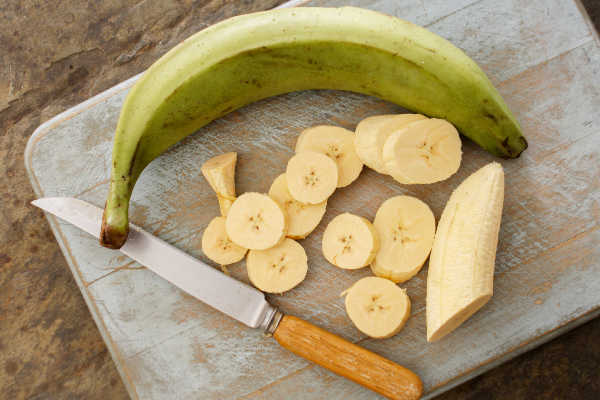
To ripen a plantain or banana, place them in a paper bag along with an apple or pear. Fold over the opening of the bag a few times to seal it, then leave it on the counter. Check each day to see if the fruit is ready to be eaten.
To find fresh plantains, search in the produce section of the supermarket, at local markets, or at Asian and African specialty grocers.
Final Words
Plantains and bananas look like very similar fruit on the supermarket shelf. An unsuspecting shopper could be excused for mixing the two up.
The most significant difference between these two fruits is taste and texture. Bananas are soft with a sweet flavor and can be eaten out of hand. In the kitchen, a plantain functions more like a vegetable and, in most situations, should be cooked for best results.

Leave a Reply